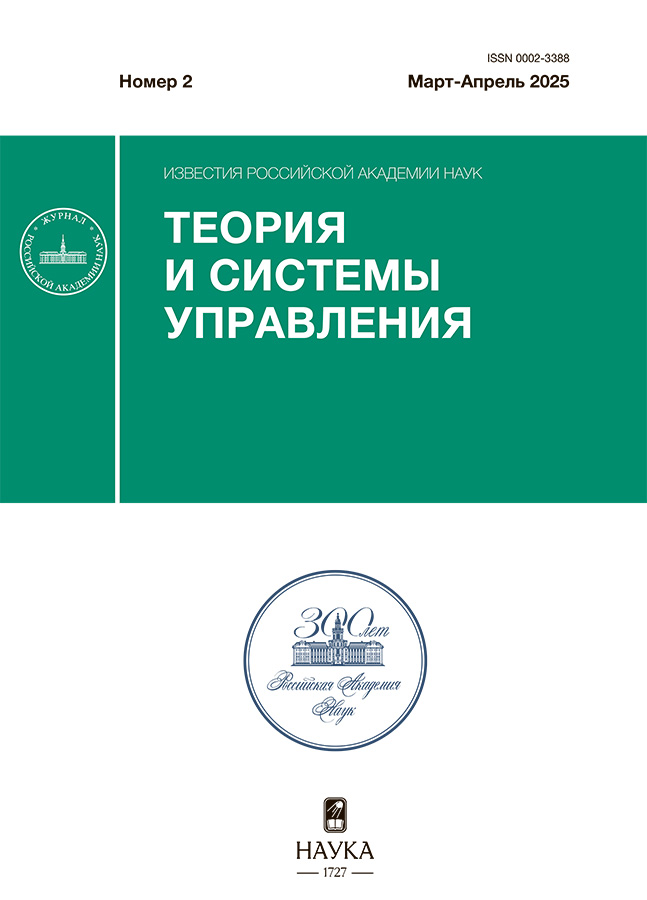Time-optimal small movement of a platform with pendulums of two types of equilibrium
- Authors: Kayumov O.R.1
-
Affiliations:
- Branch of the Omsk State Pedagogical University
- Issue: No 2 (2025)
- Pages: 29-51
- Section: OPTIMAL MANAGEMENT
- URL: https://rjonco.com/0002-3388/article/view/684878
- DOI: https://doi.org/10.31857/S0002338825020037
- EDN: https://elibrary.ru/ARRRWW
- ID: 684878
Cite item
Abstract
We consider the problem of the time-optimal small displacement of a rigid body moving forward along a horizontal straight line and carrying n mathematical pendulums. At the initial moment of time, the system is at rest, with one part of the pendulums in stable equilibrium, and the other in unstable equilibrium. The system must move a given distance with vibration damping through a single control force applied to the platform and limited in magnitude, there is no friction. The pendulums can oscillate in the vertical plane without interfering with each other due to the design, but the inverted rods must not “fall” (i.e. pass through the bottom stable vertical position). The displacement is assumed to be small to the extent that linearized equations can be used. It is shown that when the number of inverted pendulums is odd, the movement of the platform begins from reverse, but when there is an even number, it does not. For the case of two pendulums (inverted and normal), the evolution of optimal control functions with increasing range of movement is studied. The optimal control modes found for a linear system are applied to the problem of small displacement of this object with nonlinear equations.
Full Text
About the authors
O. R. Kayumov
Branch of the Omsk State Pedagogical University
Author for correspondence.
Email: Oleg_Kayumov@mail.ru
Russian Federation, Tara
References
- Черноусько Ф.Л., Акуленко Л.Д., Соколов Б.Н. Управление колебаниями. М.: Наука, 1980. 383 с.
- Понтрягин Л.С., Болтянский В.Г., Гамкрелидзе Р.В., Мищенко Е.Ф. Математическая теория оптимальных процессов. М.: Наука, 1969. 384 с.
- Мамалыга В.М. Об оптимальном управлении одной колебательной системой // Изв. АН СССР. МТТ. 1978. № 3. С. 8–17.
- Ананьевский И.М., Ишханян Т.А. Управление твердым телом, несущим диссипативные осцилляторы, в присутствии возмущений // Изв. РАН. ТиСУ. 2019. № 1. С. 42–51.
- Ovseevich A., Ananievski I. Robust Feedback for a Linear Chain of Oscillators // JOTA. 2021. V. 188. № 1. P. 307–316.
- Ананьевский И.М., Овсеевич А.И. Управляемое перемещение линейной цепочки осцилляторов // Изв. РАН. ТиСУ. 2021. № 5. С. 18–26.
- Голубев Ю.Ф. Оптимальное по быстродействию управление перемещением неустойчивого стержня // Изв. РАН. ТиСУ. 2008. № 5. С. 42–50.
- Srinivasan B., Huguenin P., Bonvin D. Global Stabilization of an Inverted Pendulum. Control Strategy and Experimental Verification // Automatica. 2009. V. 45. P. 265–269.
- Gordillo F., Aracil J. A New Controller for the Inverted Pendulum on a Cart // Int. J. Robust Nonlinear Control. 2008. № 18. P. 1607–1621.
- Мартыненко Ю.Г., Формальский А.М. Управляемый маятник на подвижном основании // Изв. РАН. МТТ. 2013. № 1. С. 9–23.
- Рапопорт Л.Б., Генералов А.А. Управление перевернутым маятником на колесе // АиТ. 2022. № 8. С. 3–28.
- Каюмов О.Р. Оптимальное по быстродействию перемещение платформы с осцилляторами // ПММ. 2021. Т. 85. Вып. 6. С. 699–718.
- Каюмов О.Р. Диаграммы функций оптимального управления в задаче наибыстрейшего перемещения платформы с двумя осцилляторами // Изв. РАН. ТиСУ. 2022. № 5. С. 66–83.
- Каюмов О.Р. О диаграммах функций оптимального управления в задаче перемещения платформы с осцилляторами // Изв. РАН. ТиСУ. 2024. № 2. С. 87–103.
- Калман Р.Е. Об общей теории систем управления // Тр. 1-го Конгресса Междунар. федерации по автоматическому управлению. М.: 1961. С. 521–546.
- Ли Э.Б., Маркус Л. Основы теории оптимального управления. М.: Наука, 1972. 574с.
- Прасолов В.В. Многочлены. М.: МЦНМО, 2003. 336 с.
Supplementary files




















